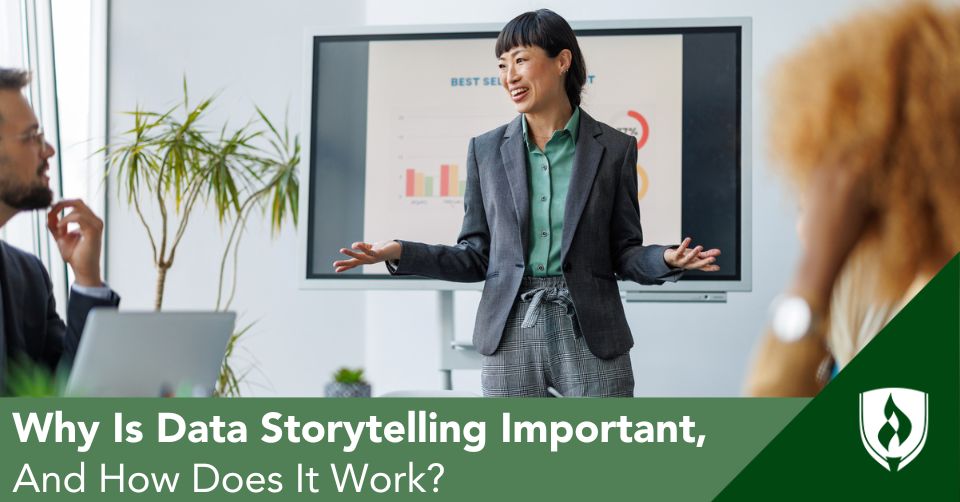
Data scientists and analysts produce meaningful insights to help business leaders make informed decisions.
Data analysis is key to understanding complex issues. Data-driven insights tell us whether a business operates efficiently, how shoppers spend their limited money and even what will persuade voters to approve or reject a new law.
But there’s a right and wrong way to present data when you’re trying to prove a point or educate your audience. Lists of figures, graphs and charts rarely, if ever, speak for themselves. Numbers alone are easy to forget; data stories, on the other hand, provide contextual narratives that are not only interesting and engaging, but also memorable.
What is data storytelling?
Data storytellers use data, narratives and visuals to effectively communicate with decision-makers. Rather than simply presenting raw data, data storytelling involves creating compelling “data stories” (narratives based on complex data analyses) to communicate analysts’ findings and provide key insights.
Data analysts use storytelling skills to explain the meaning behind raw data and show why the numbers matter. Data stories generally conclude with actionable insights and suggestions for next steps suited to stakeholders’ goals.
3 parts of telling a good story with data
Presenting data in a cohesive, clear narrative requires a conscious effort. Essentially, you need to connect the dots between the data, your findings and your listener’s main concerns.
1. Know your audience
Many types of professionals can benefit from data storytelling, but each audience will have different needs and expectations. For example, executives generally need big-picture synopses with actionable insights.
2. Focus on one critical insight
People need clear takeaways to help them process information and retain it. Too much information with too many insights can lead to confusion, and people don’t generally act when they’re confused or overwhelmed.
Data storytellers can prevent their listeners from suffering this “analysis paralysis” by identifying one key question their data answers and highlight the most relevant finding. Creating visually appealing presentations – using interactive data visualizations, for example – can also help you avoid confusing your audience.
3. Build emotion
Incorporating emotions is essential, as people connect with stories when they feel something is at stake. To evoke emotion, you need to tie the data to human outcomes.
A chart presenting a drop in sales is not as evocative as a narrative about a company that previously generated $4 million in revenue—before redesigning its website and losing $2 million in sales as a consequence. A data storytelling example
The American Heart Association® (AHA) learned the importance of data storytelling in 2015. The organization launched a campaign1 to inform the public that most instances of heart disease cases could be prevented via lifestyle changes.
But the campaign didn’t grab the public’s attention—until the AHA provided context to the numbers and statistics of their research. In select regions, the organization ran promotional content with stories about real people surviving heart attacks or losing family members to heart disease. As a result, preventative health screenings dramatically increased in these locations.
Numbers can help an audience understand important information. But data storytelling goes beyond lists, charts, tables and isolated facts. It uncovers insights and connects numbers to distinct reference points: Reference points that should be relevant to your audience.
Through data storytelling, statistics shed light on lived experiences, past challenges and opportunities for future achievements.
What are the benefits of data storytelling and data analytics?
The power of data is self-evident. Organizations in every field rely on it for informed decision-making.
Hospitals use data to manage patient care. Retailers use data to track inventory and measure customer satisfaction.
When it comes to predicting future trends or evaluating past performance, analyzing data will invariably yield better outcomes than following intuition or simply making a best guess.
How do storytelling techniques fit into today’s data-driven culture?
Consider Lara and her marketing team. Their CEO requested a progress report on a three-month-long social media campaign.
Lara is excited to show eight pages of data to the CEO and other executive leaders. She has three line graphs showing monthly follower growth. There are also bar charts comparing engagement across three different platforms. Separate pie charts depict the engagement rates for different types of posts across platforms.
It doesn’t take long for Lara and her enthusiastic team to realize the CEO and executive team aren’t as excited as they are. Their faces are blank, and the CEO’s brow is furrowed. Finally, the CEO breaks the awkward silence and asks, “But was the campaign successful? Do we have a handle on next steps?”
Lara understands her mistake: She presented the data without additional context. There’s no story to help her effectively communicate insights to her bosses.
Complex data alone won’t always reveal patterns, logical sequences, surprises—or the wins and losses that the CEO asked about. Lara’s team needs a narrative that a broader audience, like the C-suite, can follow for context.
Before their next progress report meeting, Lara consults with Bree, a data analyst who specializes in strategic communication. Her goal is to answer questions with data storytelling, rather than simply sharing the data.
What can we answer through data stories and data narratives?
Successful data storytelling provides an easy-to-follow breakdown of complex information. And since companies can collect data on virtually any subject, there’s almost no limit on the types of questions that data stories can answer.
Here are just a few examples:
- What do we know about our most loyal customers?
- What is the impact of changing our prices?
- What can we do differently to ensure we reach our goals?
In Lara’s case, data storytelling can help answer questions about how her company may use social media to run targeted marketing campaigns in the future. She and Bree can craft a compelling narrative about the strategy she used and the results it yielded. From there, they can deliver actionable insights to the CEO and other members of the leadership team.
Bree and Lara illustrate why storytelling is such a powerful tool and how it helps fill in the gaps of non-narrative data reporting.
Crafting compelling stories requires data analysts to be skillful writers, speakers and narrators, so they can share their findings in a truly engaging manner. Data stories are meant to guide decision-makers, rather than providing them with troves of data.
How do data narratives and visual elements work together?
The data, narrative and visual elements are all essential to data storytelling. First, the data is the basis of the quantifiable facts that decision-makers need to know.
The narrative element of a data story provides the context that connects the numbers to statistics, demographics and other pertinent information.
Similar to the narrative in a good novel or movie, the narrative in a data story must have a clear, easy-to-follow structure. It needs a background, a conflict and a resolution.
The background helps stakeholders understand why this data was collected in the first place and how it solves an important problem.
Visuals can include charts, graphs and tables. These visual representations of key data points complement the narrative and highlight the statistics decision-makers need to know.
People are drawn to stories; even our ancient ancestors loved them. Nothing helps us make sense of complex ideas and confusing situations better than stories.
How do you create a compelling data story?
Consider Gianna, a project manager sharing the findings from her latest undertaking. She tells stakeholders, “This quarter, customer logins increased by 8%, support tickets dropped by 12% and churn decreased from 7.2% to 5.8%. Our net promoter score went up by 3 points.”
Even if Gianna includes a graph or chart in her presentation, it’s unclear what the insights derived from these figures are. She is missing the key elements of data storytelling: background, conflict and resolution. Her audience has no reason to connect with the data.
After developing storytelling skills and knowledge, Gianna changes her approach:
“At the start of Q1, we launched our in-app onboarding assistant to address user confusion and reduce support dependency. Since then, logins have increased by 8%, and support tickets have dropped by 12%, a sign that users are navigating the platform more confidently.”
“Most importantly, churn decreased to 5.8%, the lowest in 12 months, and our NPS climbed by 3 points. These results suggest our new onboarding tool is driving real user satisfaction and retention. For Q2, I recommend we integrate the onboarding assistant within our mobile interface.”
Through the power of data storytelling, Gianna was able to translate seemingly vague statistics into a compelling narrative. Gianna’s data story tells the stakeholders exactly how her latest project helped to support business outcomes.
She presented a clear background, conflict and resolution, as follows:
- Background – Gianna’s team launched an onboarding process to curtail user confusion.
- Conflict – Confused users were overwhelming the company’s help desk with support tickets.
- Resolution – After launching the onboarding assistant, logins increased, support tickets decreased, customer churn decreased churn and the company’s NPS rose. Using a narrative format enabled Gianna to show the stakeholders precisely how she achieved a positive outcome. Her presentation also communicated the logic behind Gianna’s recommendations for next steps.
Gianna’s storytelling makes it easy for decision makers to see what the numbers mean, in terms of customer feelings, experiences and behaviors.
What’s the difference between data storytelling and data visualization?
It’s important not to confuse storytelling with visualization. Data visualization involves visual representations of data, like charts, tables and graphs.
These visuals can be a powerful tool for showing patterns, increases, decreases and other relationships between data points. Still, it’s important to note that data visualizations show the “what” without explaining the “why” or “how.” Therefore, data visualizations don’t provide enough information to make data-driven decisions.
On the other hand, data storytelling combines data with a narrative and complementary visuals. A data story is a coherent message that stakeholders can connect with and trust as a guide for decision-making, change management and risk assessment.
Data storytelling ultimately helps the audience draw conclusions and understand the best possible next steps.
Data storytelling plays a key role in today’s business landscape
The true value of analytics lies not in gathering numbers and presenting lists of facts, but in turning those numbers and facts into stories—with actionable insights.
Effective data storytelling bridges the gap between raw data and decision-making by engaging stakeholders through emotion and logic. Data storytelling makes insights memorable, understandable and meaningful, whether focused on public health behaviors, business strategy or customer preferences.
Ultimately, the ability to create meaningful narratives out of complicated data is one of the most essential skills a data analyst can have.
Since data-driven decision-making and data analysis techniques are such a huge facet of business today, they are part of the coursework students do in Rasmussen University’s online Business Management degree programs.
If you really like what we can learn from data, you might want to check out data analytics, where learning how to generate this data, as well as present it will be your main focus.
Check out Is Data Analyst a Good Career? 8 Things to Consider.
American Heart Association is a registered trademark of American Heart Association, Inc.
NPS is a registered trademark of Nice Systems Inc.
1Sudden Cardiac Arrest Foundation website, AHA Releases 2015 Heart and Stroke Statistics, viewed 7/9/25
